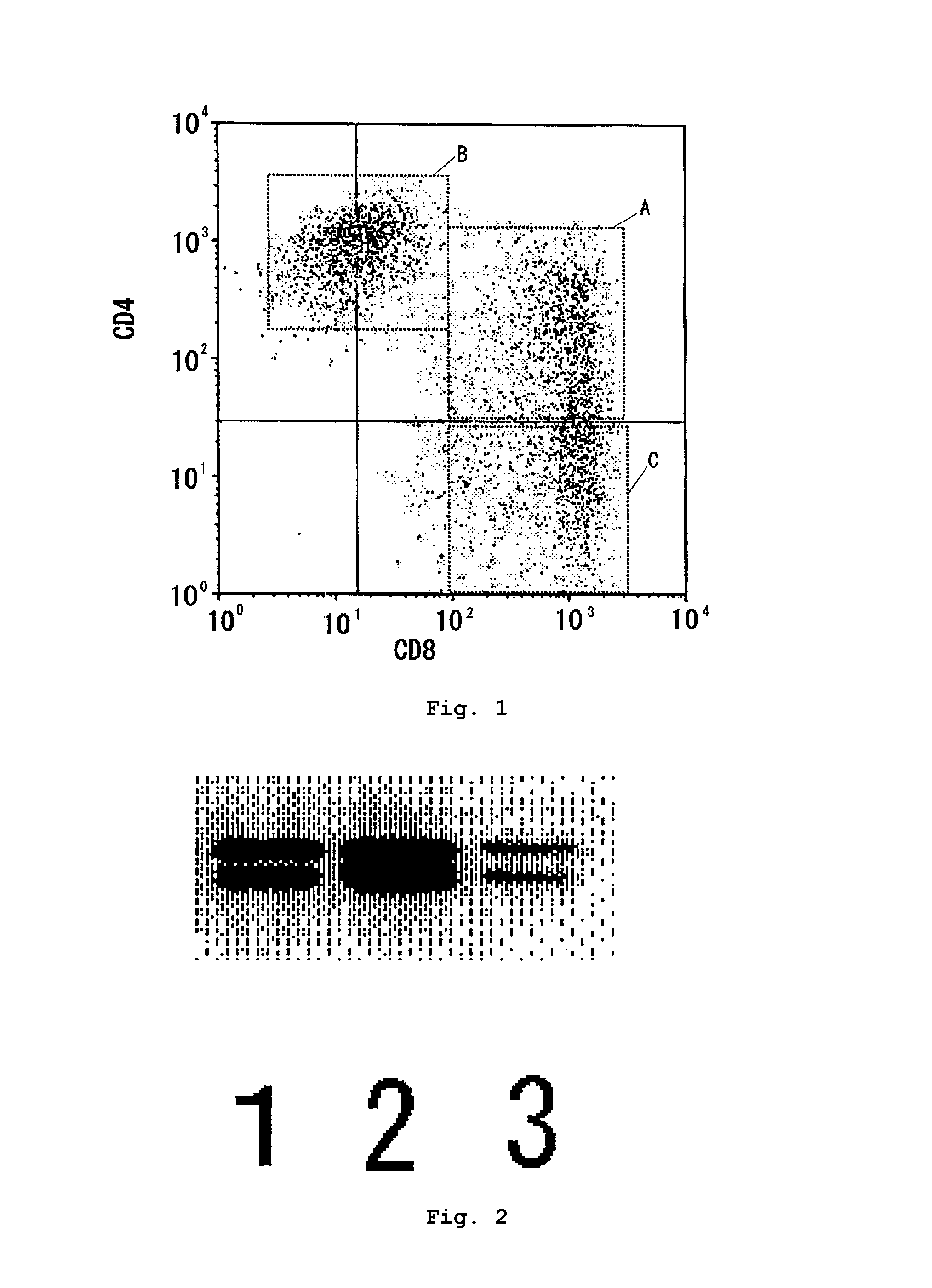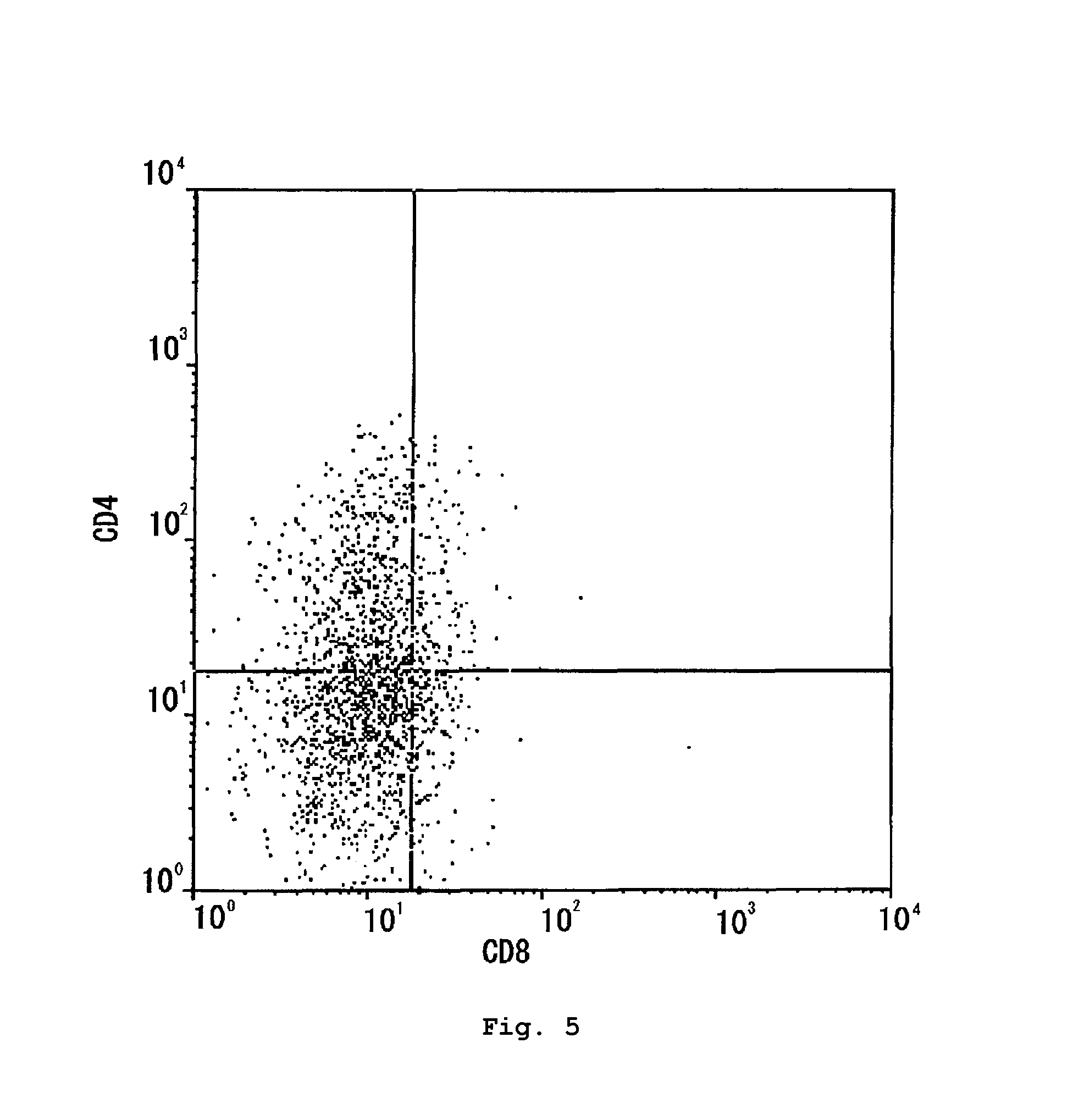Human T-cell population
a human tcell population and cell technology, applied in the field of human tcell populations, can solve the problems of not being used as pharmaceuticals, finding any human stroma cell line that can be cultured, and not working on the exclusion mechanism, so as to relieve the reaction of rejection
- Summary
- Abstract
- Description
- Claims
- Application Information
AI Technical Summary
Benefits of technology
Problems solved by technology
Method used
Image
Examples
example 1
Preparation of Human T-cell Population from Cord Blood
[0044]Blood specimens were collected from umbilical cords, which had been resected, when in delivery, from seven pregnant women (U1 to U7) who had received informed consent, and each specimen was diluted with RPMI1640 medium by about two times by volume, and in usual manner overlaid on FICOLL-HYPAQUE, and centrifuged to collect a layer containing mononuclear cells, followed by washing it with physiological saline to collect the mononuclear cells. “CD34 ISOLATION KIT”, commercialized by Miltenyi Biotec Inc., CA, USA, was applied to the above mononuclear cells to remove CD34 positive mononuclear cells and to collect CD34 negative mononuclear cells. The resulting CD34 negative mononuclear cells were suspended in RPMI1640 medium supplemented with 10% (v / v) fetal calf serum and inoculated at a cell number of 3×106 cells per well to commercialized 6-well microplates, which ST2 cells (RCB0224 available from RIKEN BioResource Center, Tsu...
example 2
Analysis of Cell Membrane Antigen
[0045]By flow cytometry analysis using an antibody against a cell membrane antigen relating to human lymphocyte, the human T cell populations obtained in Example 1 were analyzed. The testing cells (U1 to U7) were treated for 30 min with antibodies against the antigens as listed in the following Table 1; a mouse anti-CD3 antibody (commercialized by Nichirei Biosciences Inc., Tokyo, Japan), mouse anti-CD4 antibody (commercialized by Nichirei Biosciences Inc., Tokyo, Japan), mouse anti-CD8α antibody (produced by Bechman Coulter K.K., Tokyo, Japan), mouse anti-CD25 antibody (produced by Bechman Coulter K.K., Tokyo, Japan), mouse anti-CD45RA antibody (produced by Bechman Coulter K.K., Tokyo, Japan), mouse anti-CD45RO antibody (commercialized by Nichirei Bioscience Inc., Tokyo, Japan), mouse anti-CD28 antibody (commercialized by Nichirei Bioscience Inc., Tokyo, Japan), mouse anti-CD56 antibody (produced by Bechman Coulter K.K., Tokyo, Japan), mouse anti-HL...
example 3
Double Staining Analysis Using Anti-CD4 Antibody and Anti-CD8 Antibody
[0048]According to usual manner, the seven human T cell populations (U1 to U7) obtained in Example 1 were double stained using a phycoerythrin-labeled mouse anti-CD4 antibody and a fluorescein isothiocyanate-labelled mouse anti-CD8 antibody (produced by Japan Becton, Dickinson and Company, Tokyo, Japan) and analyzed for flow cytometry by the method similarly as in Example 2. The human T cell populations U1, U2, U3 and U5 were re-analyzed one to two weeks after the first measurement. The results are in Table 2. The data in the upper and lower columns are respectively those for the first and second measurements. As representative examples, FIG. 1 is a figure of flow cytometry for human T-cell population U3 (first measurement).
[0049]
TABLE 2Group AGroup BGroup CHuman T cell(CD4+CD8+)(CD4+CD8dim)(CD4−CD8+)Totalpopulation(%)(%)(%)(%)U127.113.459.299.730.632.236.098.8U245.015.836.897.643.724.031.098.7U325.549.223.898.551...
PUM
| Property | Measurement | Unit |
|---|---|---|
| detection wavelength | aaaaa | aaaaa |
| detection wavelength | aaaaa | aaaaa |
| pH | aaaaa | aaaaa |
Abstract
Description
Claims
Application Information
 Login to View More
Login to View More - R&D
- Intellectual Property
- Life Sciences
- Materials
- Tech Scout
- Unparalleled Data Quality
- Higher Quality Content
- 60% Fewer Hallucinations
Browse by: Latest US Patents, China's latest patents, Technical Efficacy Thesaurus, Application Domain, Technology Topic, Popular Technical Reports.
© 2025 PatSnap. All rights reserved.Legal|Privacy policy|Modern Slavery Act Transparency Statement|Sitemap|About US| Contact US: help@patsnap.com



